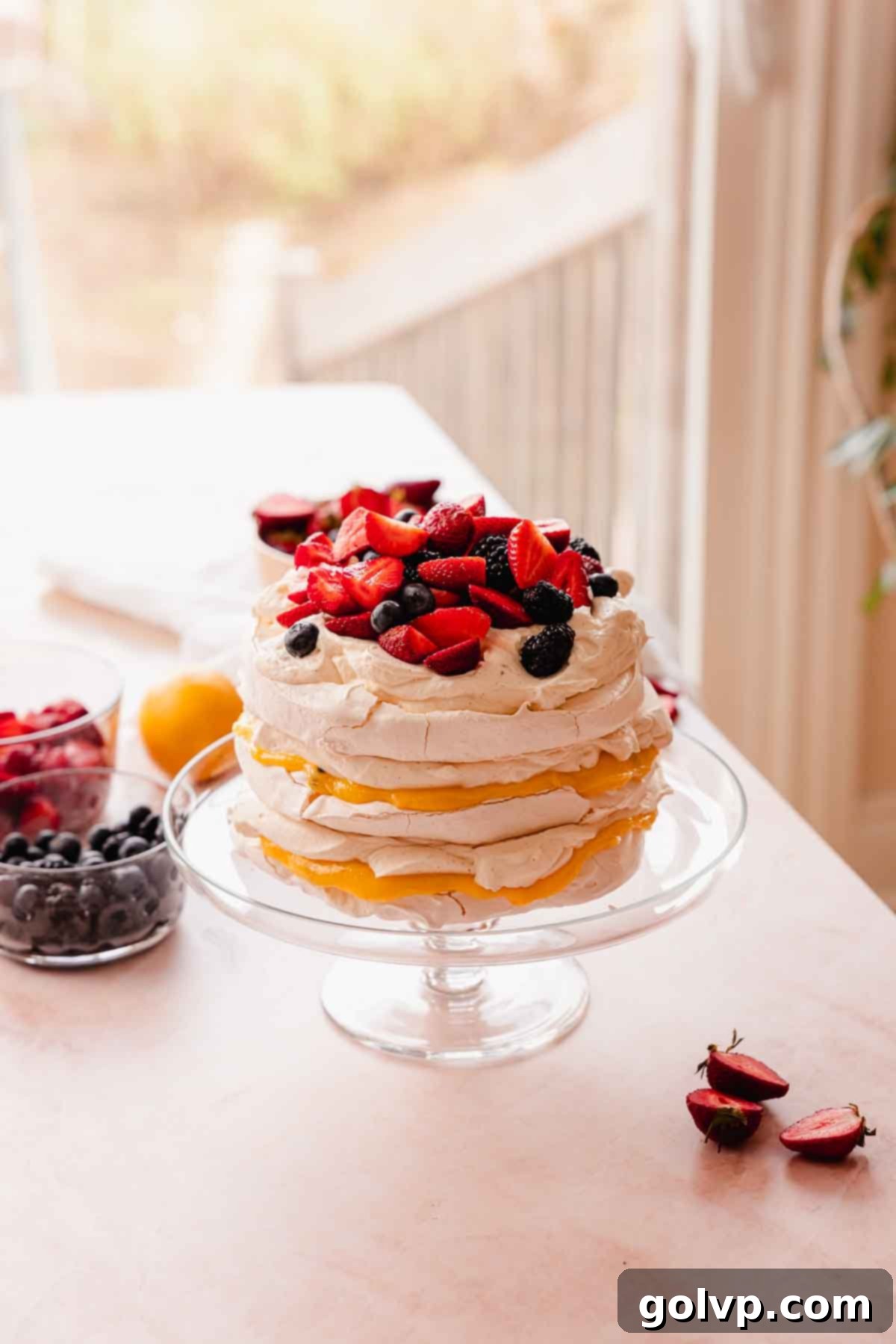Easy Stacked Pavlova Cake with Tangy Lemon Passion Fruit Curd and Whipped Mascarpone Cream
Prepare to be enchanted by this show-stopping stacked pavlova cake, a true summer masterpiece that effortlessly combines elegance with incredible flavor. Each individual layer of this delightful dessert features a perfectly crisp meringue exterior that yields to a melt-in-your-mouth, marshmallow-soft interior. Sandwiched between these ethereal pavlova discs is a vibrant and luscious lemon passion fruit curd, offering a tantalizing balance of tangy and creamy notes. To complete this symphony of textures and tastes, a fluffy, stabilized mascarpone whipped cream adds an irresistible richness. Crowned with an abundance of fresh, juicy berries, this cake isn’t just a dessert; it’s an experience, promising to be the highlight of any warm-weather gathering.
Unlike traditional, larger pavlovas that can be daunting to bake due to their propensity for cracking and collapsing, this stacked version is remarkably forgiving and much easier to master. The smaller, individual layers require less baking time and are far more stable, significantly reducing the chances of oven mishaps. This makes it an ideal recipe for both seasoned bakers and ambitious beginners looking to create something truly spectacular. It’s not just a beautiful pavlova cake, but a smart and fun twist on a beloved classic, ensuring a perfect outcome every time.
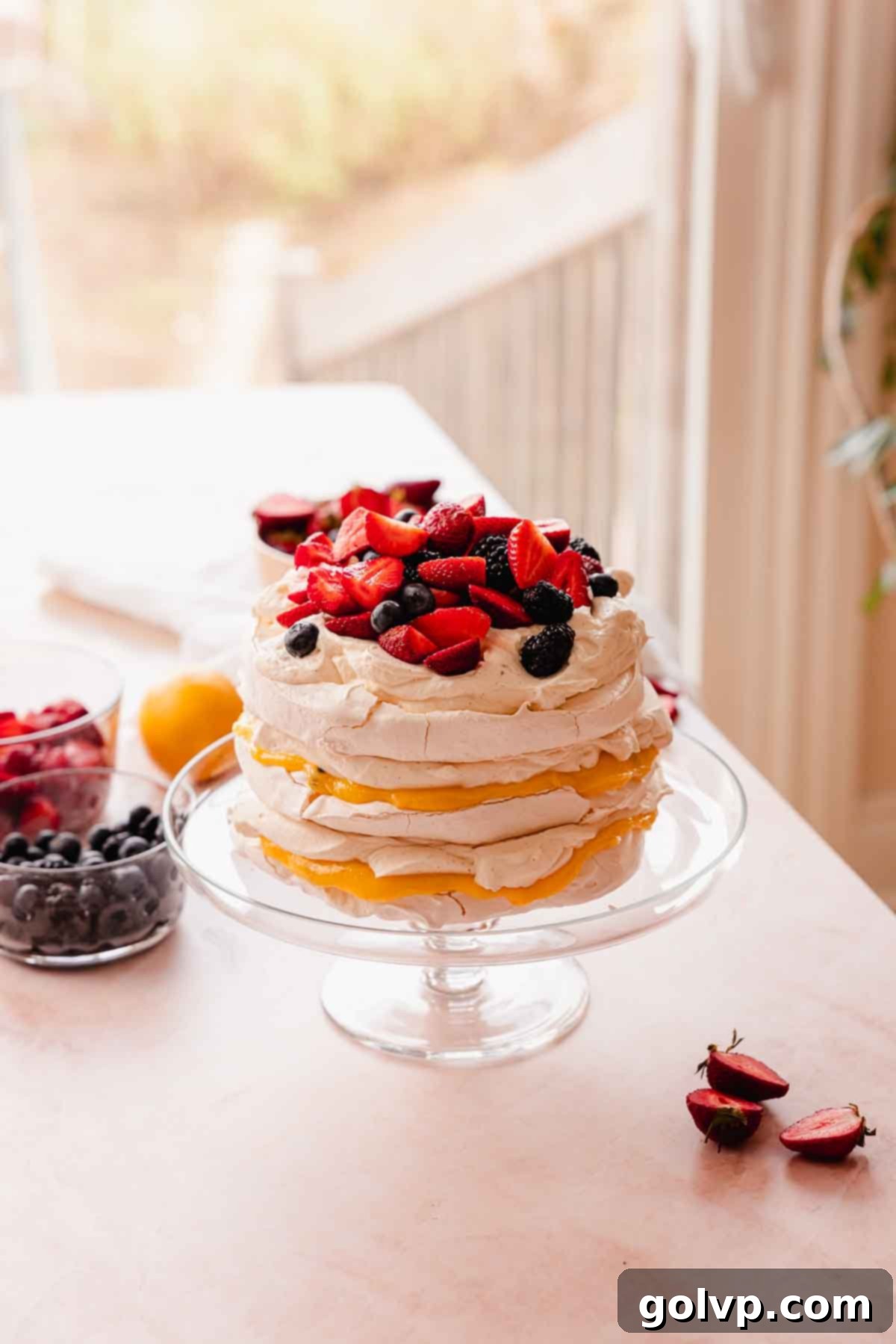
Why You’ll Adore This Stacked Pavlova Recipe
This recipe transforms the classic pavlova into an approachable yet incredibly impressive dessert. Here’s why it’s destined to become your new favorite:
- Effortless Stacked Pavlova Layers: Forget the anxiety of a giant pavlova collapsing! This stacked design is inherently more foolproof. Baking smaller meringue discs significantly reduces the risk of cracking and deflation in the oven, leading to perfectly structured layers with that coveted crisp-on-the-outside, soft-on-the-inside texture. Plus, they bake faster, making the process smoother and more enjoyable.
- Luxurious Lemon Passion Fruit Curd: No precious egg yolks go to waste here! The yolks, separated for the pavlova meringue, are ingeniously transformed into an incredibly thick, smooth, and utterly luxurious lemon curd. The addition of fresh passion fruit infuses it with an exotic, tangy sweetness and a delightful textural crunch from the seeds, creating the perfect bright and zesty filling for your pavlova cake.
- Stabilized Mascarpone Whipped Cream: Achieve peak creamy perfection with our mascarpone whipped cream. This recipe incorporates mascarpone cheese, which not only stabilizes the whipped cream (preventing it from deflating too quickly) but also imbues it with an ultra-rich, velvety mouthfeel. Infused with vanilla bean paste, you’ll even see beautiful vanilla specks, adding an extra layer of gourmet appeal and flavor.
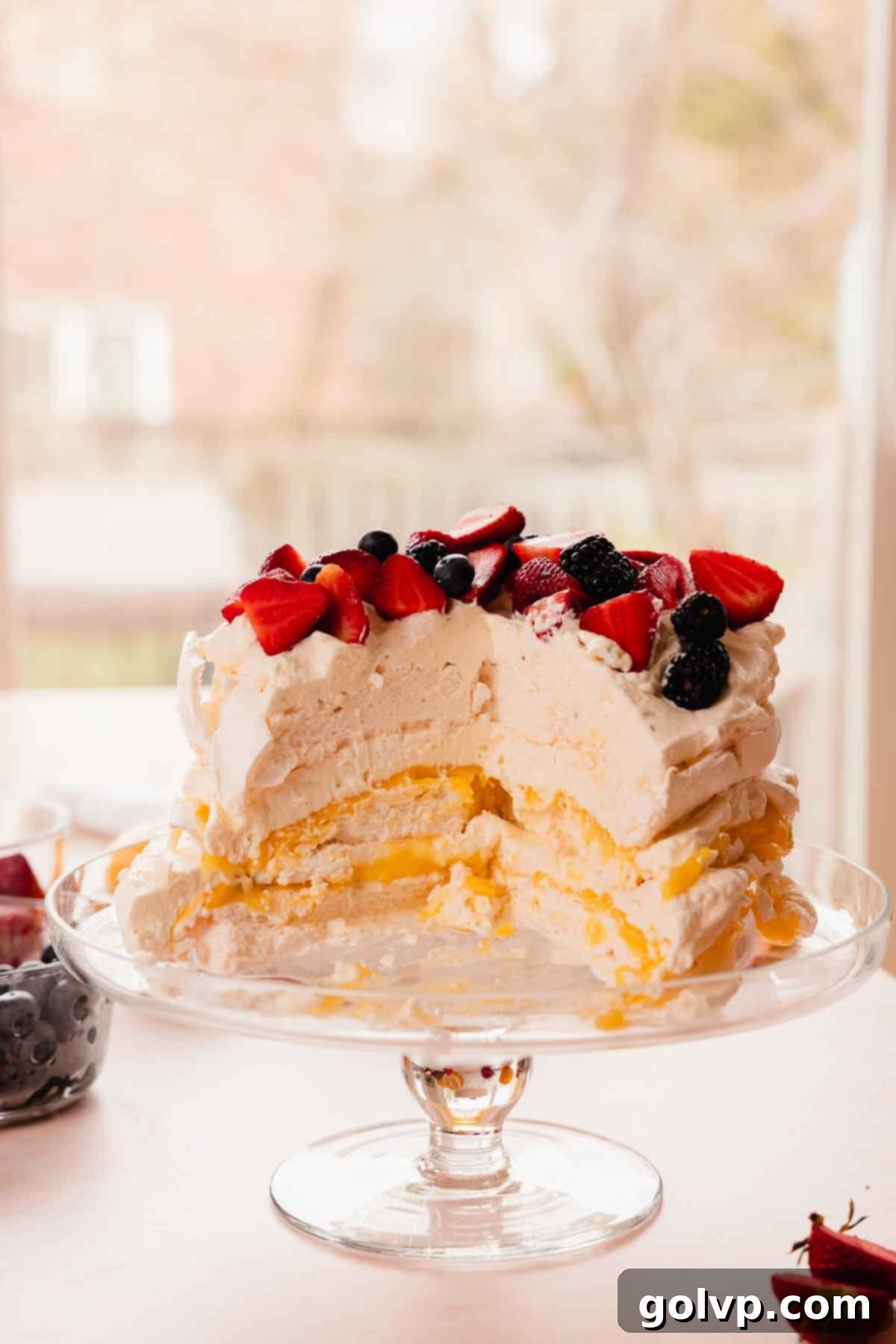
Key Ingredients for the Perfect Stacked Pavlova
For the most successful and delicious stacked pavlova cake, understanding the role of each ingredient is essential. Let’s dive into the core components that make this recipe truly special.
Full steps and ingredients can be found in the detailed recipe card below.

Eggs: This recipe utilizes six large eggs, making it incredibly efficient. The egg whites are crucial for forming the airy, stable structure of the pavlova meringue, while the yolks are put to excellent use in crafting the rich, flavorful lemon passion fruit curd. Ensure your eggs are cold when separating, as cold egg whites are generally easier to separate cleanly from the yolks. However, for whipping, it’s often recommended to use room temperature egg whites for maximum volume. For pavlova, cold egg whites work well with cream of tartar to achieve stable peaks quickly.
Granulated Sugar: Sugar is not just for sweetness in meringue; it’s integral to its structure. For the pavlova layers, a slightly finer granulated sugar is preferred as it dissolves more readily into the egg whites, creating a smooth, stable meringue without a gritty texture. If your granulated sugar is particularly coarse, a quick pulse in a food processor can help achieve a finer consistency, leading to a silkier meringue. Ensure the sugar is fully dissolved before adding other ingredients.
Cream of Tartar: This acidic ingredient is a secret weapon for perfect meringues. Cream of tartar acts as a stabilizer, helping the egg whites whip up faster, achieve greater volume, and form very stiff, resilient peaks that are less likely to collapse. It also contributes to the crisp exterior of the pavlova. If you don’t have cream of tartar, a teaspoon of white vinegar or fresh lemon juice can be used as a substitute, but cream of tartar generally provides the most reliable results for pavlova.
Cornstarch: A small amount of cornstarch is vital for the signature pavlova texture. It works by absorbing any excess moisture from the egg whites, preventing the meringue from becoming sticky or weeping. During baking, it helps to set the meringue into its beautiful, pillowy soft interior, contrasting wonderfully with the crisp outer shell. Cornstarch is key to a pavlova that holds its shape, doesn’t deflate, and boasts that perfect crisp-soft balance.
Lemon Juice: Freshly squeezed lemon juice is paramount for the curd, providing its characteristic bright and tangy flavor. In this recipe, we intentionally omit lemon zest to allow the subtle, tropical notes of the passion fruit to shine through without being overpowered. The fresh juice ensures a clean, zesty profile that beautifully cuts through the sweetness of the meringue and cream.
Passion Fruit: Just one fresh passion fruit transforms the lemon curd into something truly special. Its distinct tropical aroma and tart-sweet pulp introduce a complex flavor dimension that elevates the curd beyond a simple lemon version. Furthermore, the tiny, edible black seeds of the passion fruit add a delightful, subtle crunch, providing an unexpected textural contrast within the smooth curd.
White Chocolate: The inclusion of a bar of chopped white chocolate in the lemon passion fruit curd is a culinary cleverness. While it doesn’t overtly announce its presence with a strong chocolate flavor, it acts as a silent enhancer. It contributes extra sweetness, a luscious creaminess, and helps to thicken the curd to a luxurious, spreadable consistency. This subtle addition truly elevates the curd, making it feel more opulent and indulgent.
Heavy Whipping Cream: For the most voluptuous whipped cream, always use heavy whipping cream (typically 35% milk fat). The high fat content ensures it whips up beautifully with plenty of volume and stability. Crucially, the cream must be very cold, straight from the fridge. Cold cream whips faster and holds its peaks better, which is essential for a stable and fluffy topping.
Mascarpone Cheese: This Italian cream cheese is a game-changer for whipped cream. Mascarpone significantly helps to stabilize the whipped cream, making it less prone to deflating and weeping, especially when the cake sits for a while. Beyond stability, it imparts an incredibly rich, luxurious, and velvety smooth mouthfeel, making the cream taste even more indulgent and decadent.
Vanilla Bean Paste: Elevate your whipped cream with vanilla bean paste. Unlike extract, the paste delivers a more intense, authentic vanilla flavor. The tiny, visible specks of vanilla bean add a touch of gourmet sophistication, visually hinting at the rich, natural vanilla taste within.
How to Make this Exquisite Berry Pavlova Layered Cake
Crafting this stunning stacked pavlova cake is a rewarding process. Follow these step-by-step instructions for each component to achieve perfection.
Perfecting Your Pavlova Layers Step-by-Step
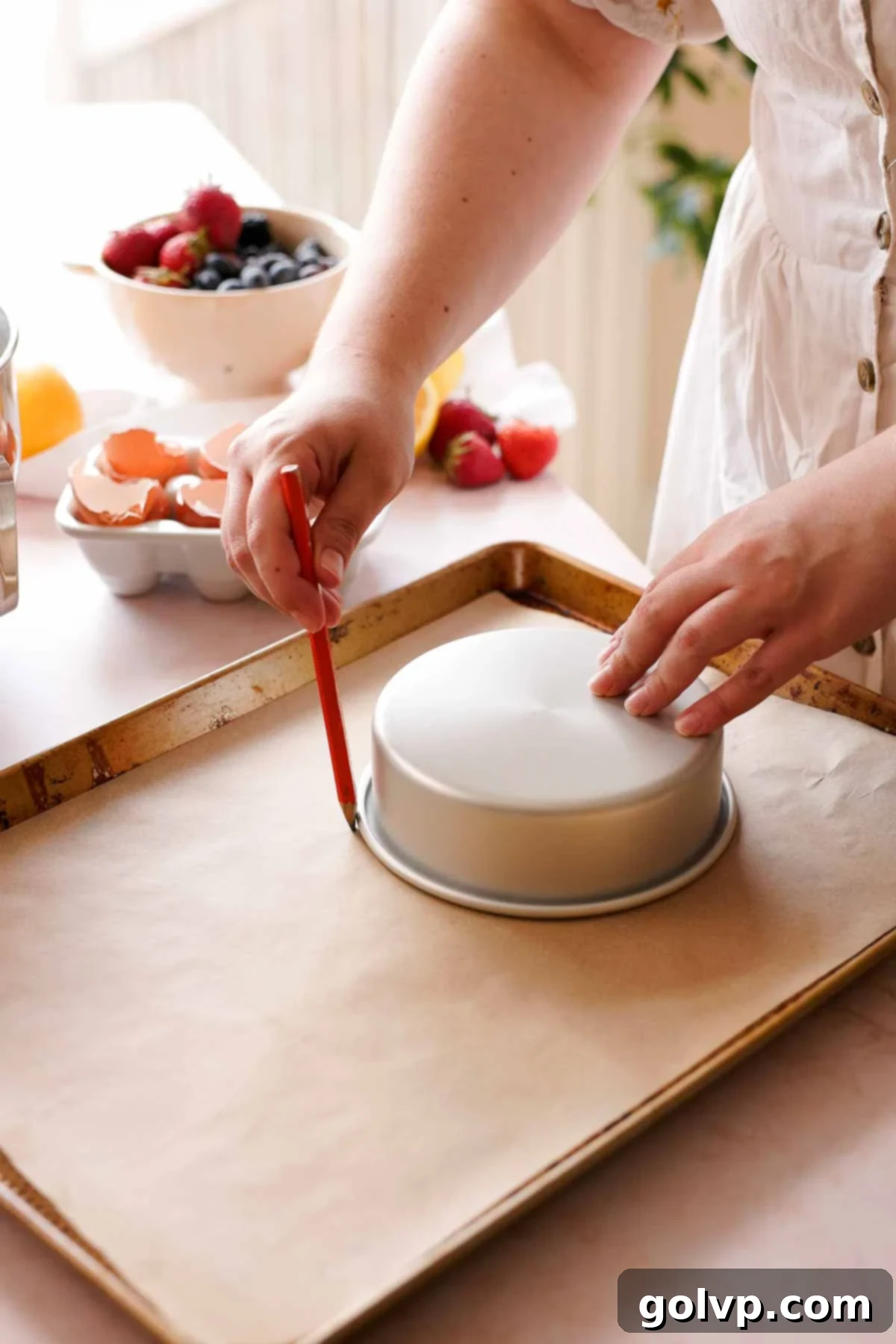
Step 1: Prepare Your Baking Sheets. Begin by preheating your oven to 340°F (170°C). This initial higher temperature is crucial for quickly setting the pavlova’s exterior, preventing cracks. Next, grab a plate or cake pan with a diameter of approximately 6 to 7 inches – this will be your guide. On several sheets of parchment paper, carefully trace three circles using a pencil. Once traced, flip the parchment paper over so the pencil marks are on the underside (this prevents graphite from transferring to your meringue). Lay these prepared parchment papers onto your baking sheets.
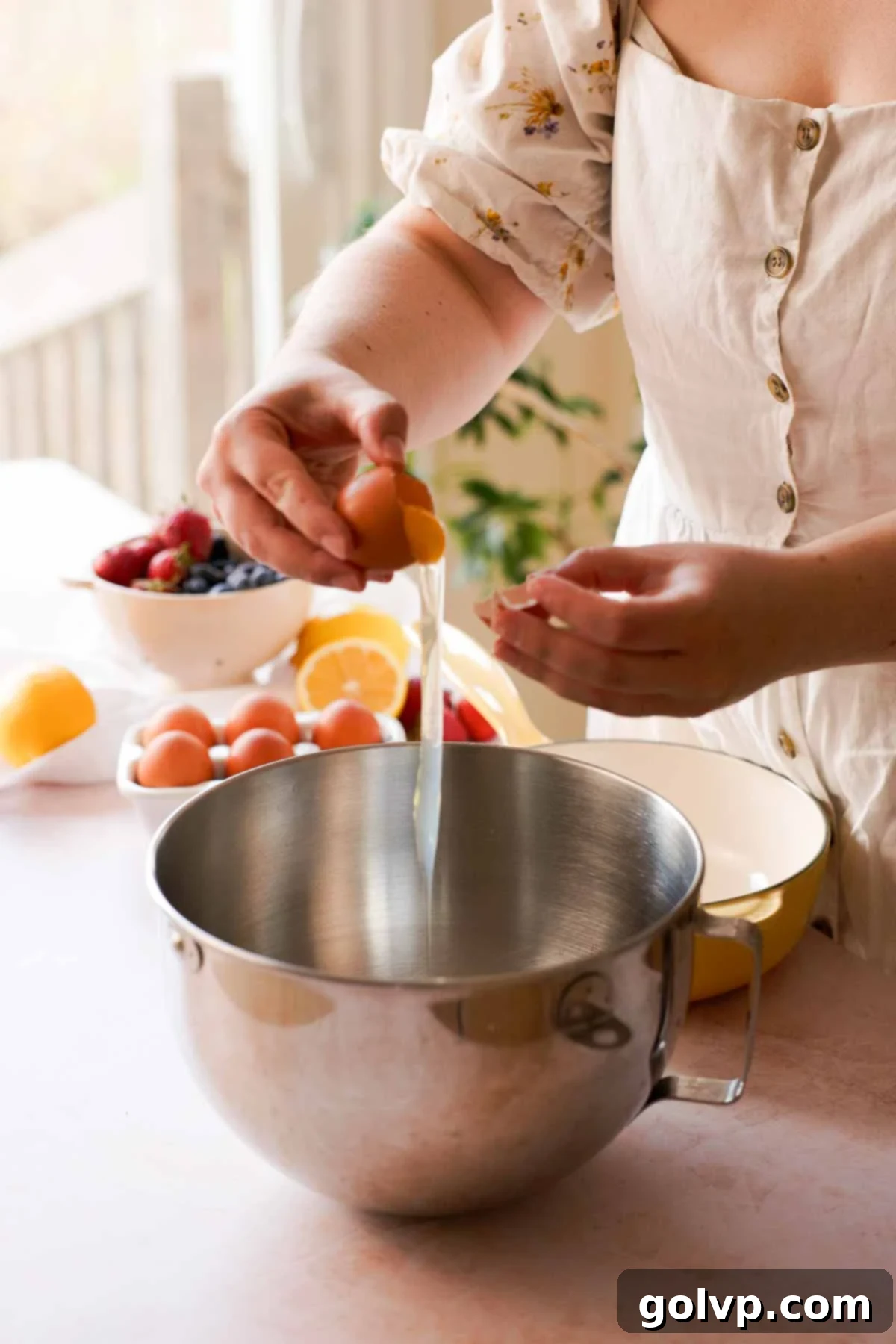
Step 2: Carefully Separate Eggs. The success of your pavlova hinges on perfectly separated eggs. Crack each egg with extreme caution, ensuring not even a trace of egg yolk contaminates the whites. Even a tiny amount of fat from the yolk can prevent the egg whites from whipping up properly. Place the pristine egg whites into a thoroughly clean and bone-dry bowl of a stand mixer. It’s imperative that the bowl and whisk attachment are free from any grease or moisture.
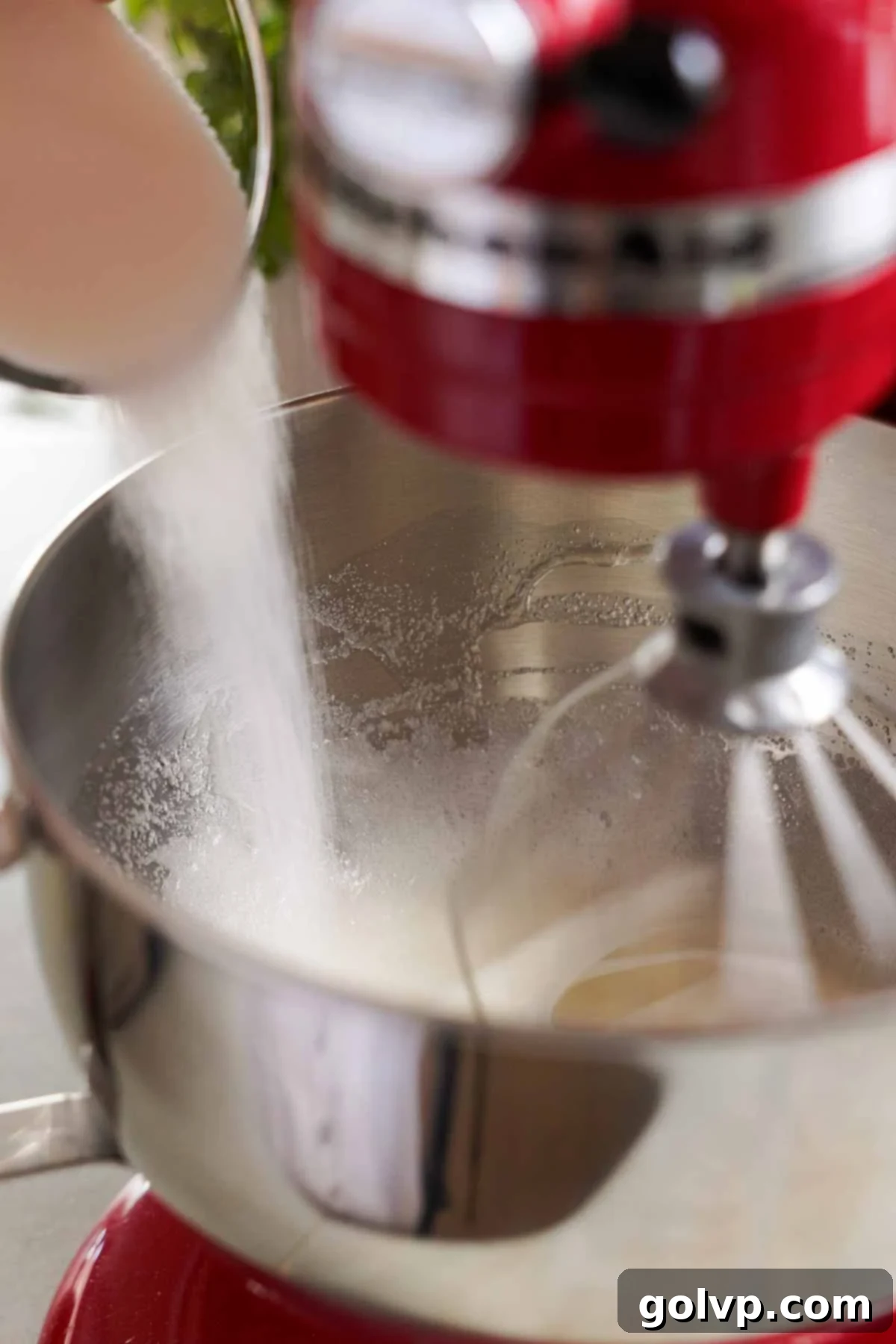
Step 3: Begin Whipping and Add Sugar. Add the cream of tartar to the egg whites in the stand mixer bowl. Start whipping on medium-high speed with the whisk attachment. After about 30 seconds, once the egg whites become frothy, begin adding the granulated sugar gradually, approximately one tablespoon at a time. This slow addition allows the sugar to dissolve completely into the egg whites as they whip, preventing a gritty meringue and ensuring a stable, glossy result.
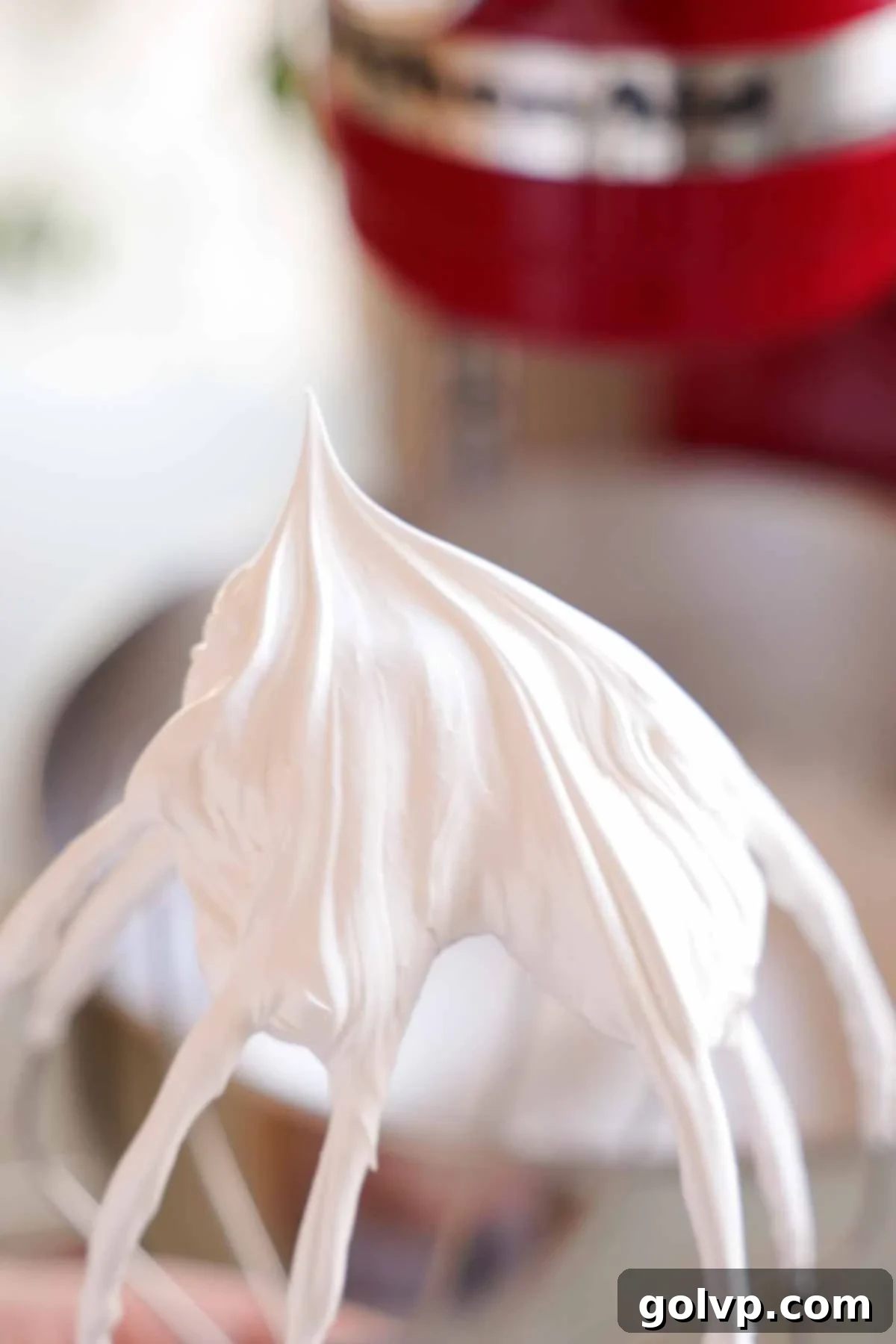
Step 4: Achieve Stiff, Glossy Peaks. Continue whipping the meringue mixture for approximately 10 minutes. It’s ready when it reaches stiff, glossy peaks. To test, pull the whisk out of the mixture; the meringue should hold its shape firmly without drooping. Additionally, rub a small amount of meringue between your fingers – it should feel smooth, indicating that all the sugar crystals have completely dissolved, not gritty.
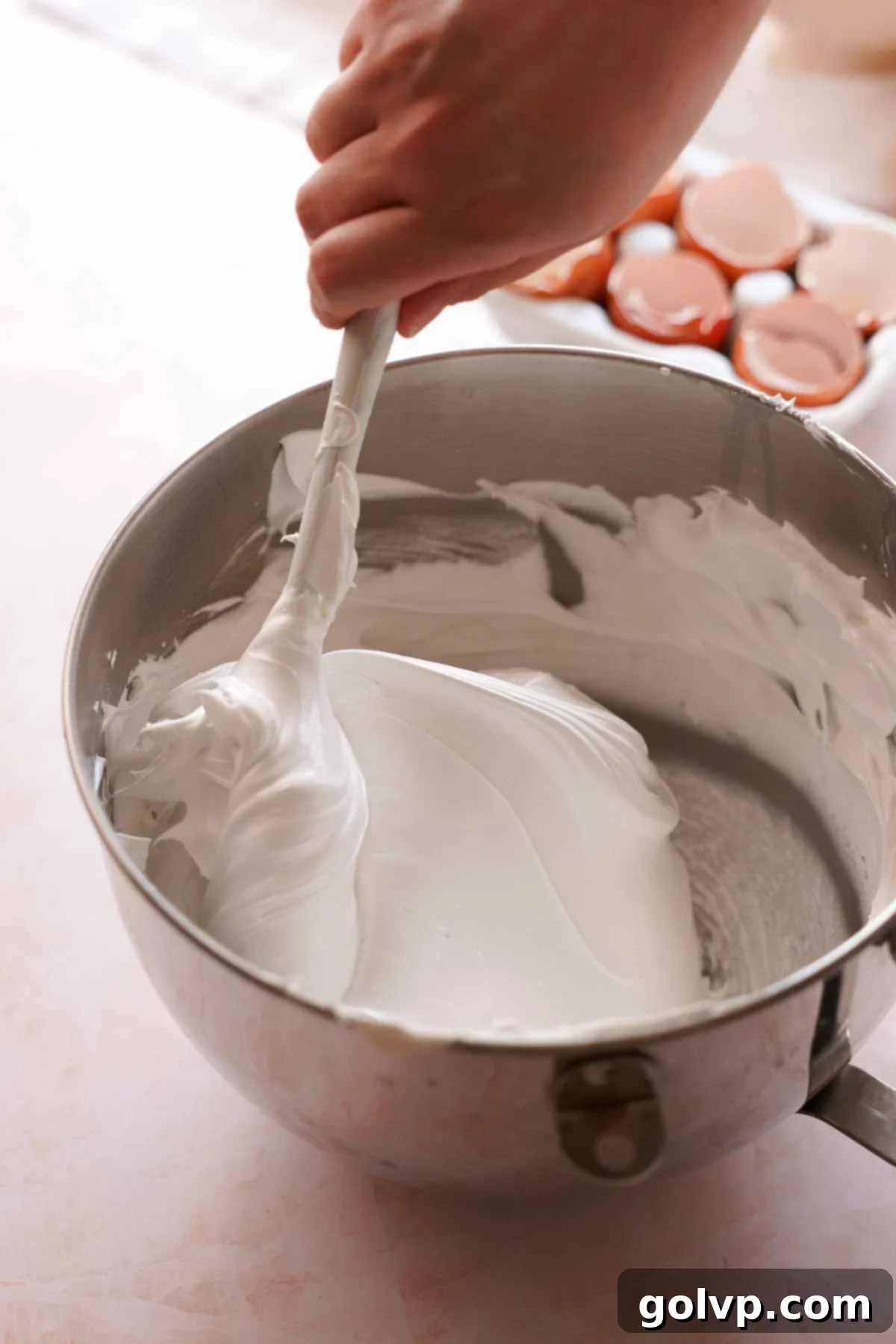
Step 5: Incorporate Vanilla and Cornstarch. Briefly mix in the pure vanilla extract on low speed. Then, gently sprinkle the cornstarch evenly over the meringue. Using a spatula, carefully fold the cornstarch into the meringue with light, upward motions. Be cautious not to overmix, as this can deflate the precious air you’ve whipped into the meringue, compromising its texture and volume.
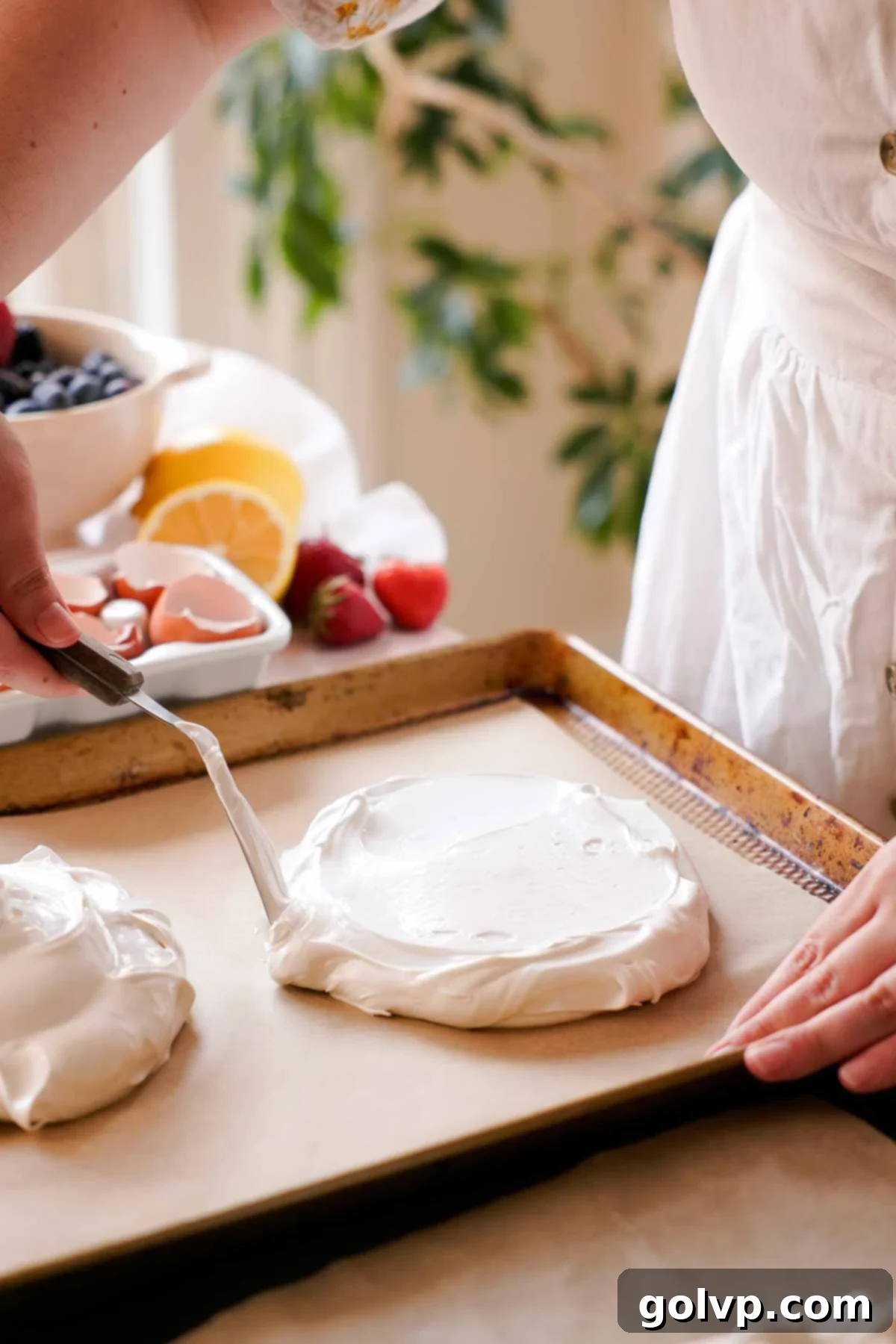
Step 6: Shape the Pavlova Discs. Divide the meringue mixture evenly into the centers of the three traced circles on your parchment-lined baking sheets. Using the back of a spoon or a small offset spatula, gently smooth out the meringue into even, flat discs, using the traced circles as your guide. Remember to leave a small margin, as the pavlova layers will spread slightly, by about half an inch, during baking.
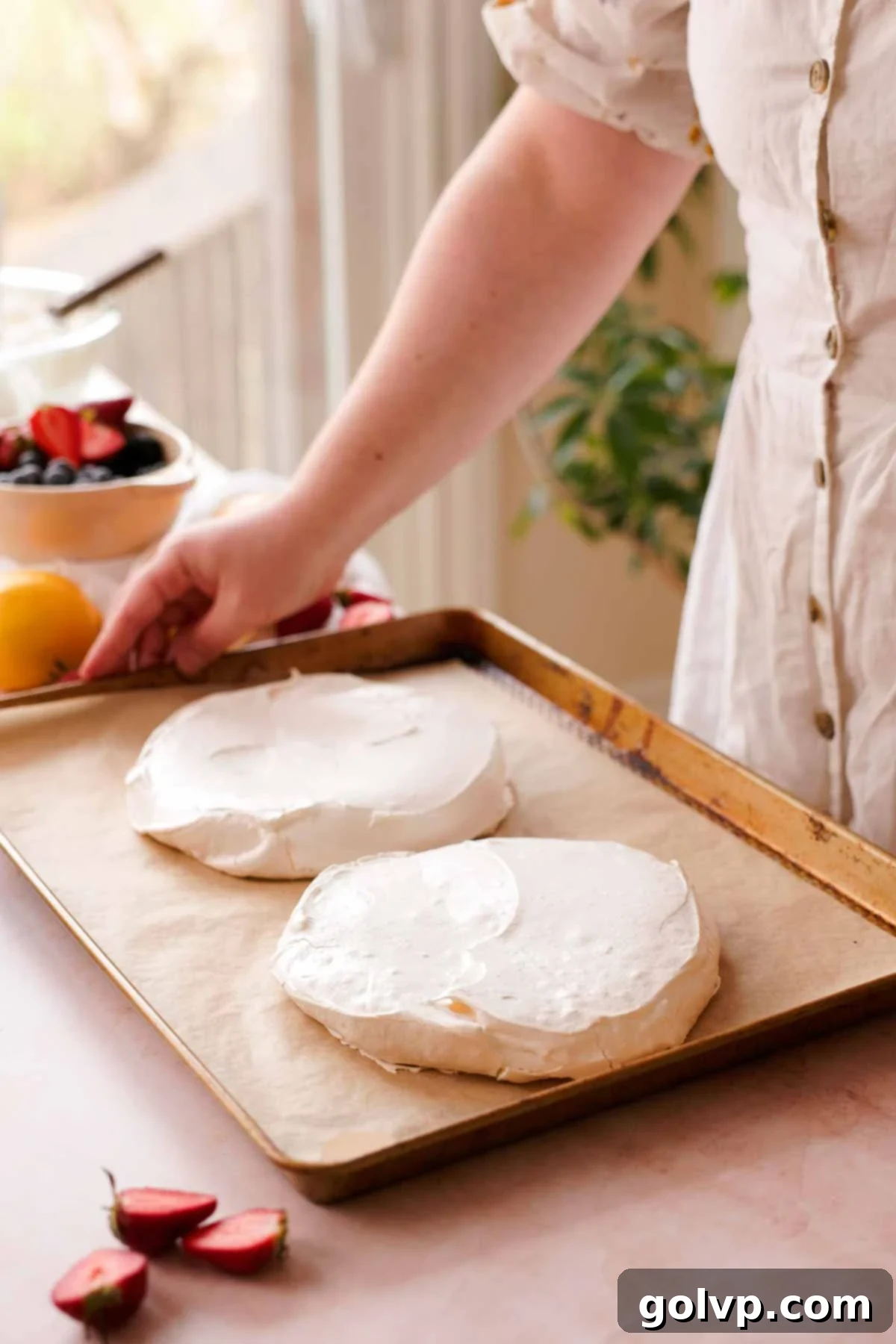
Step 7: Bake and Cool the Pavlova. Place the baking sheets with the meringue into the preheated oven. Immediately close the oven door and reduce the temperature to a low 240°F (115°C). Bake for exactly one hour. It is crucial NOT to open the oven door during this time, as sudden temperature fluctuations can cause the pavlova to crack or deflate. After one hour, turn off the oven completely, but leave the pavlova inside to cool slowly and gradually. This slow cooling process is vital for achieving the perfect crisp exterior and soft, chewy interior, and further prevents cracking. You can let them cool for one to two hours, or even better, leave them in the oven overnight for optimal results. While the pavlova bakes and cools, you can begin preparing the delightful curd.
Crafting the Lemon Passion Fruit Curd Step-by-Step
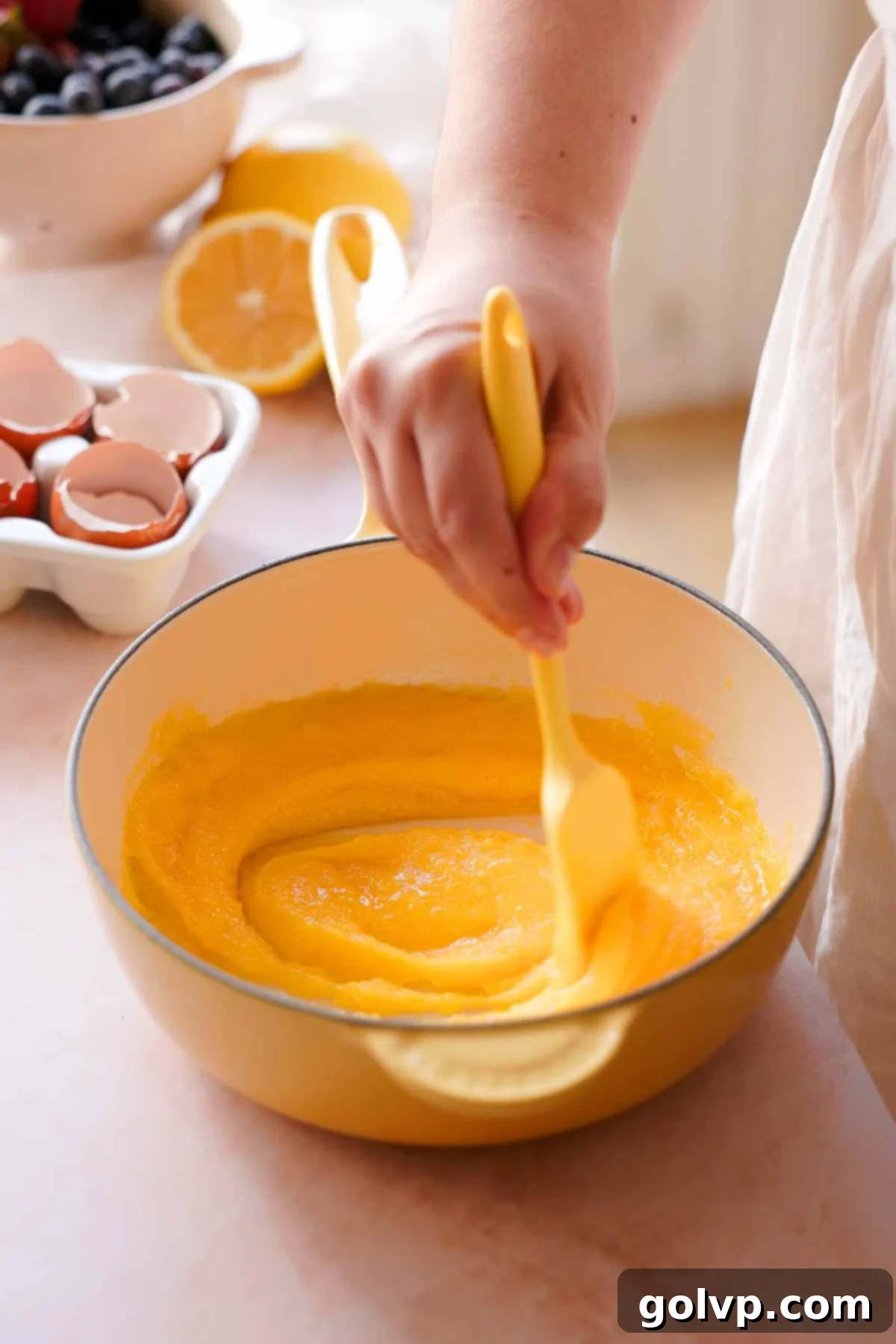
Step 1: Combine Yolks and Sugar. In a medium-sized saucepan, combine the six large egg yolks (leftover from your pavlova prep) with the granulated sugar. Whisk them together thoroughly until the mixture is well combined and slightly pale. This initial step helps to break down the sugar crystals and prepare the yolks for cooking.
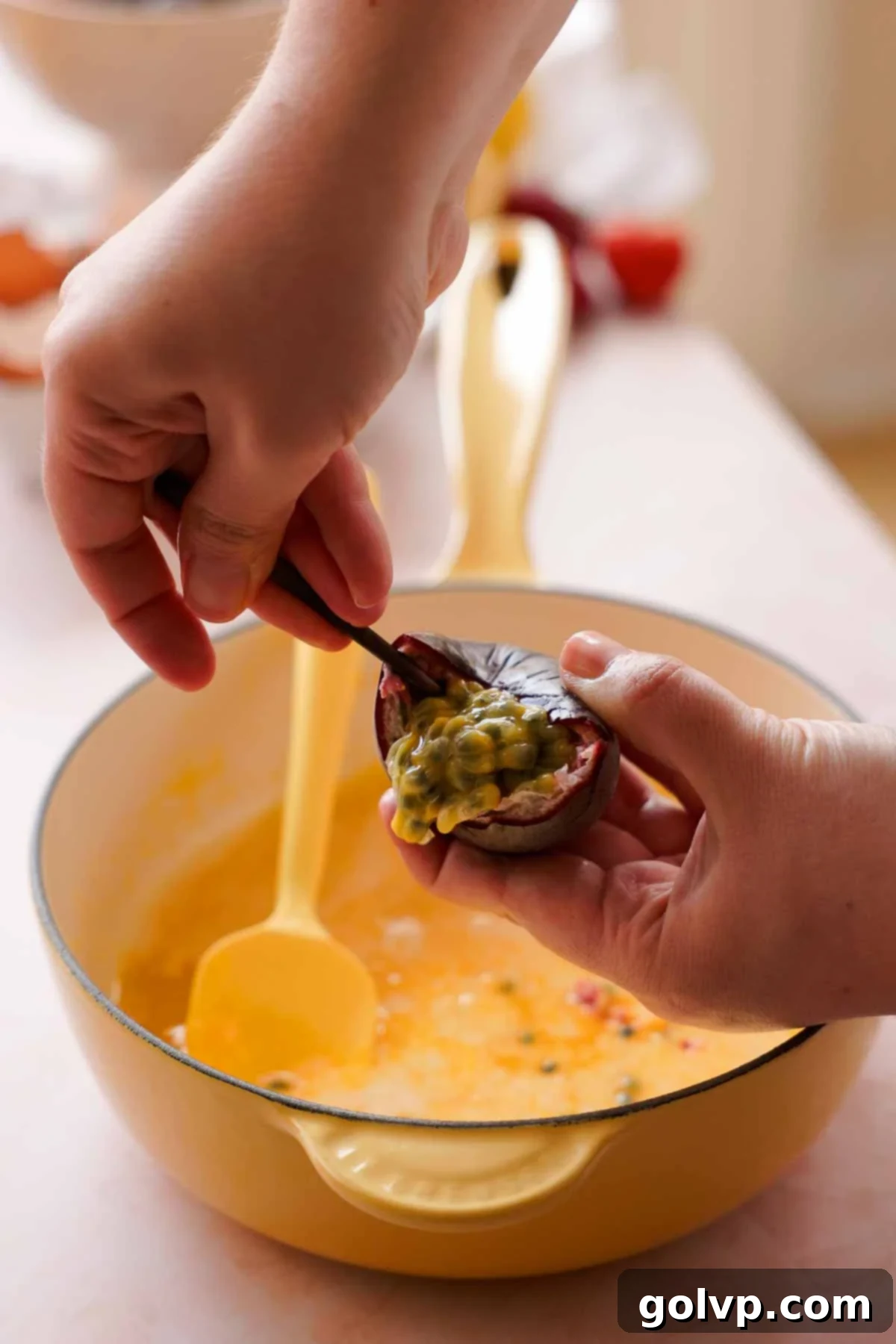
Step 2: Cook the Curd Base. Add the freshly squeezed lemon juice and scoop out the juicy pulp and seeds from one fresh passion fruit directly into the saucepan. Place the saucepan over low heat and begin stirring frequently. It’s crucial to stir constantly to prevent the eggs from scrambling and to ensure even cooking. Continue heating and stirring until the mixture comes to a gentle boil and visibly thickens, coating the back of a spoon. This typically takes about 8-10 minutes. The curd should be thick enough to hold a line when a finger is drawn across the spoon.
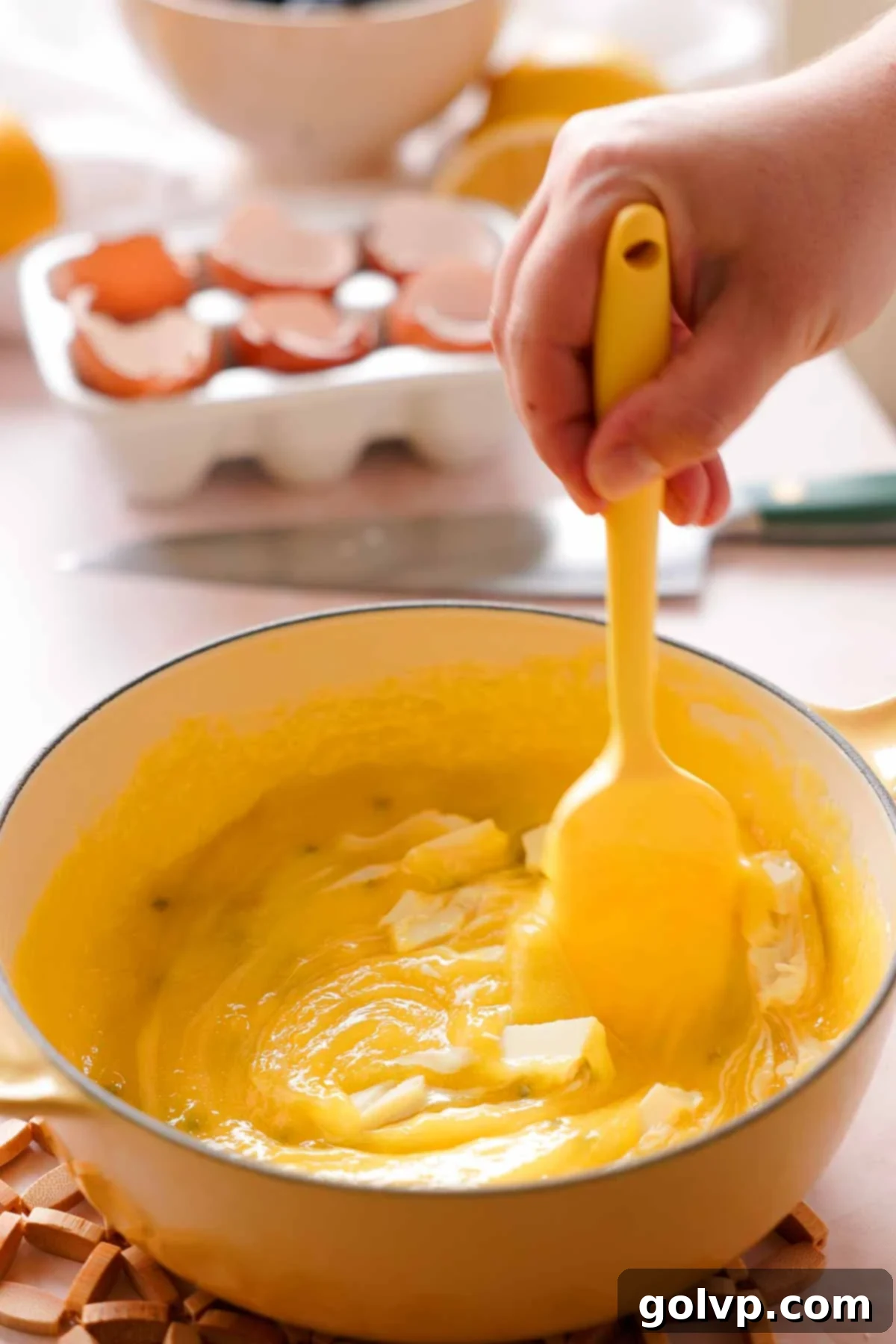
Step 3: Finish with White Chocolate and Butter. Immediately remove the thickened curd from the heat. Add the chopped white chocolate, softened butter, and a pinch of sea salt to the hot curd. Stir continuously until the white chocolate and butter are completely melted and smoothly incorporated into the curd. The residual heat from the curd will be sufficient to melt these ingredients, resulting in a glossy, rich, and beautifully textured filling.
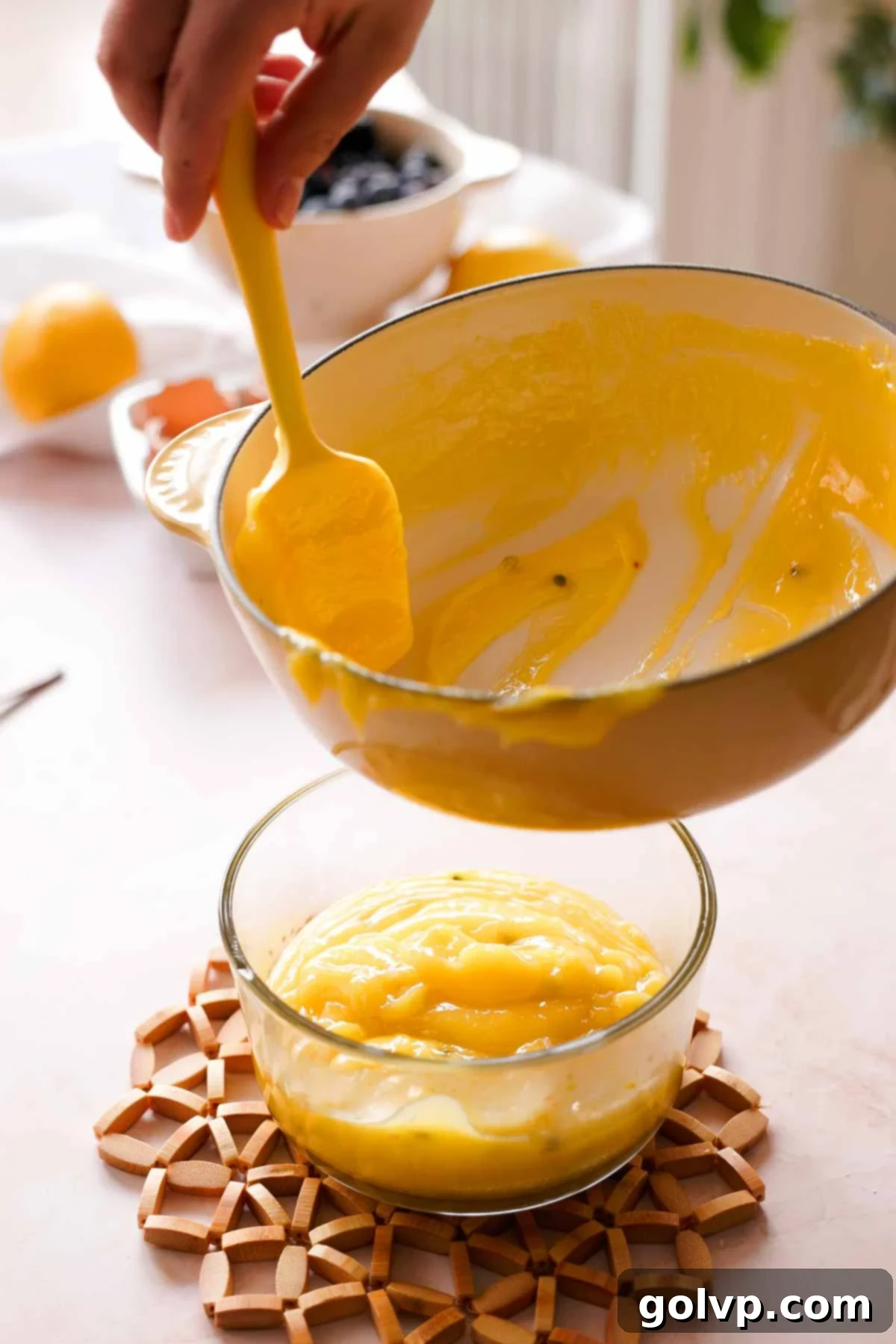
Step 4: Chill the Curd. Transfer the finished lemon passion fruit curd into an airtight container. Press a piece of plastic wrap directly onto the surface of the curd to prevent a skin from forming as it cools. Refrigerate the curd until it is thoroughly chilled and firm enough to spread, typically several hours or overnight. This cooling process is essential for the curd to set and achieve its perfect consistency.
Whipped Cream Preparation and Cake Assembly Step-by-Step
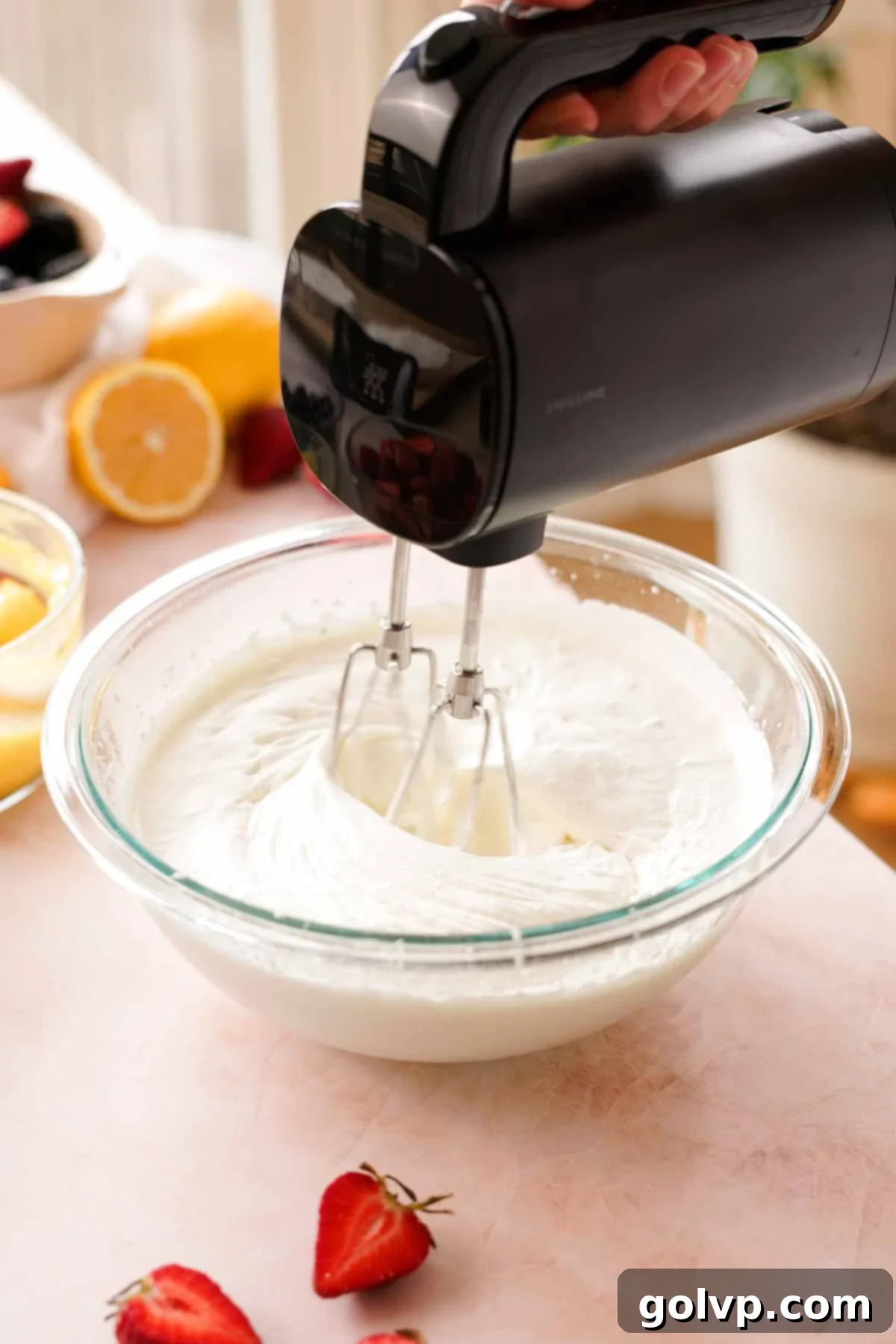
Step 1: Whip Cream to Medium Peaks. On the day you plan to assemble and serve your pavlova cake, prepare the whipped cream. In a large, chilled bowl of a stand mixer fitted with a whisk attachment (or using an electric hand mixer), combine the very cold heavy whipping cream and granulated sugar. Whip on medium-high speed until the mixture forms soft to medium peaks. It should hold its shape somewhat but still be light and airy.
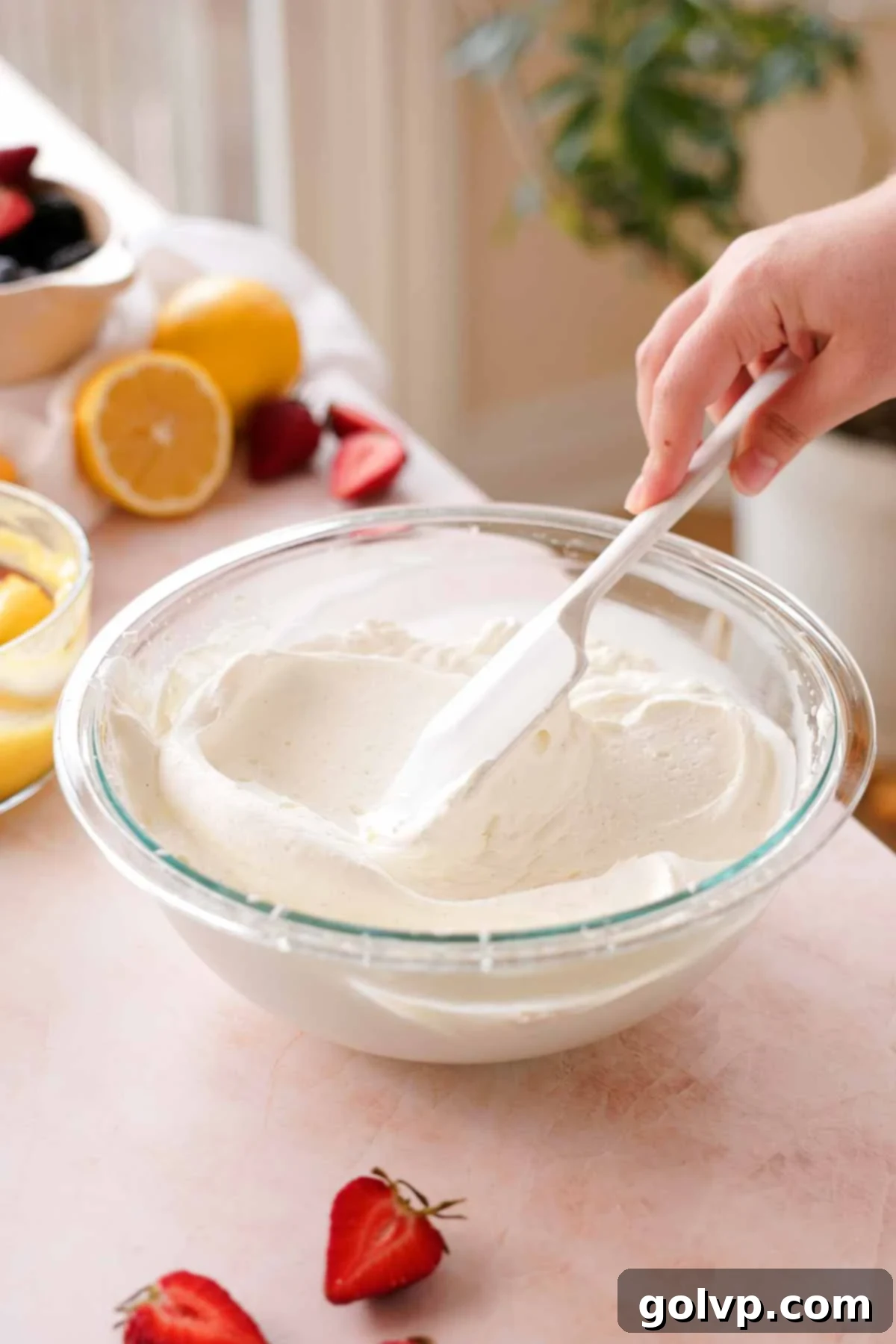
Step 2: Add Mascarpone and Whip to Stiff Peaks. To the whipped cream, add the chilled mascarpone cheese, vanilla bean paste, and a pinch of sea salt. Continue whipping on medium-high speed until the cream reaches stiff peaks. It should be thick, smooth, and hold its shape firmly, creating a stable and luscious topping for your cake.
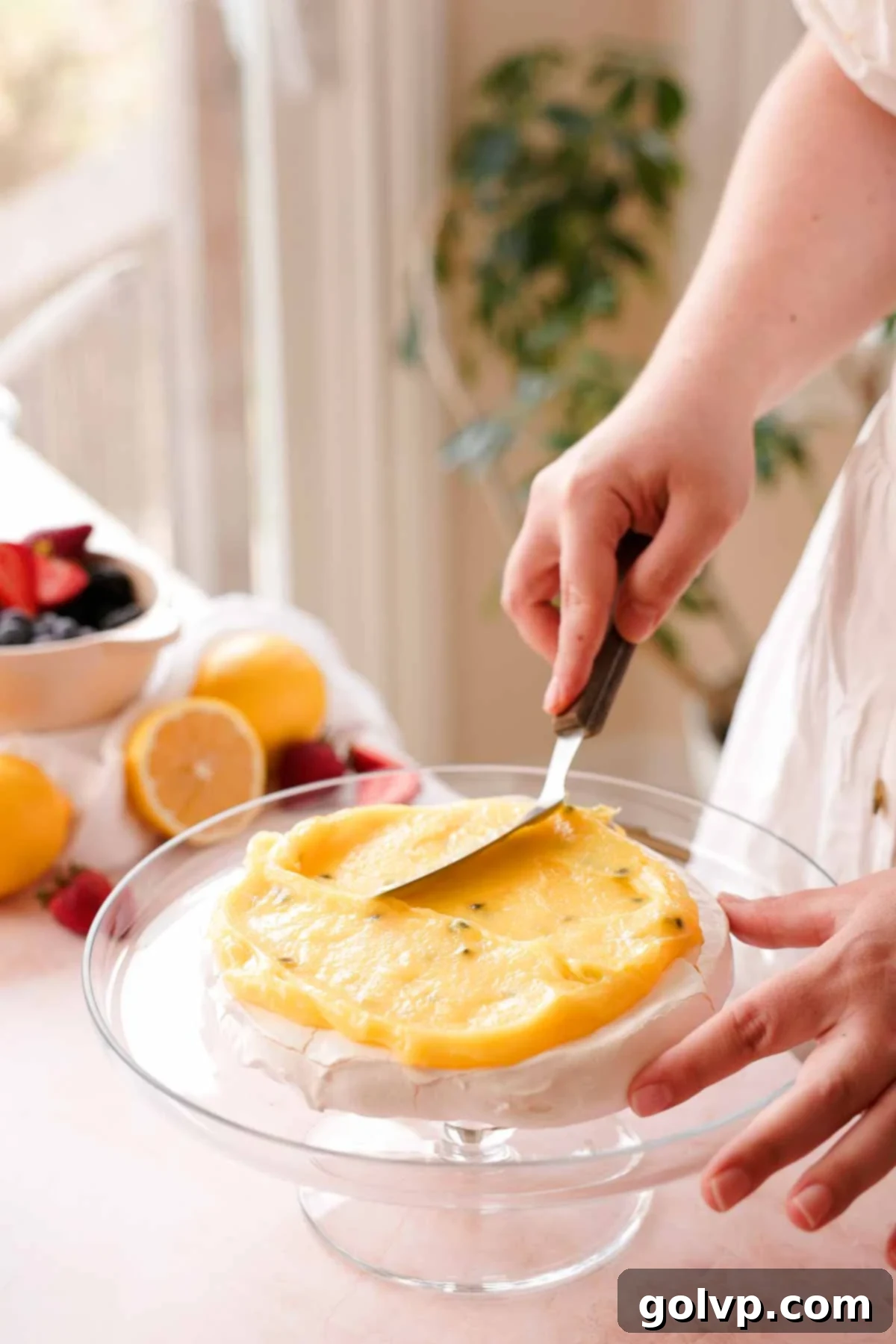
Step 3: Begin Stacking. Gently and carefully peel the cooled pavlova disks from the parchment paper. They will be delicate. To secure the first layer, place a small dollop of the mascarpone whipped cream onto your chosen large cake plate or cake stand. This acts as an anchor. Position the first pavlova layer on top. Evenly spread half of the thoroughly chilled lemon passion fruit curd over this layer, extending it almost to the edges.
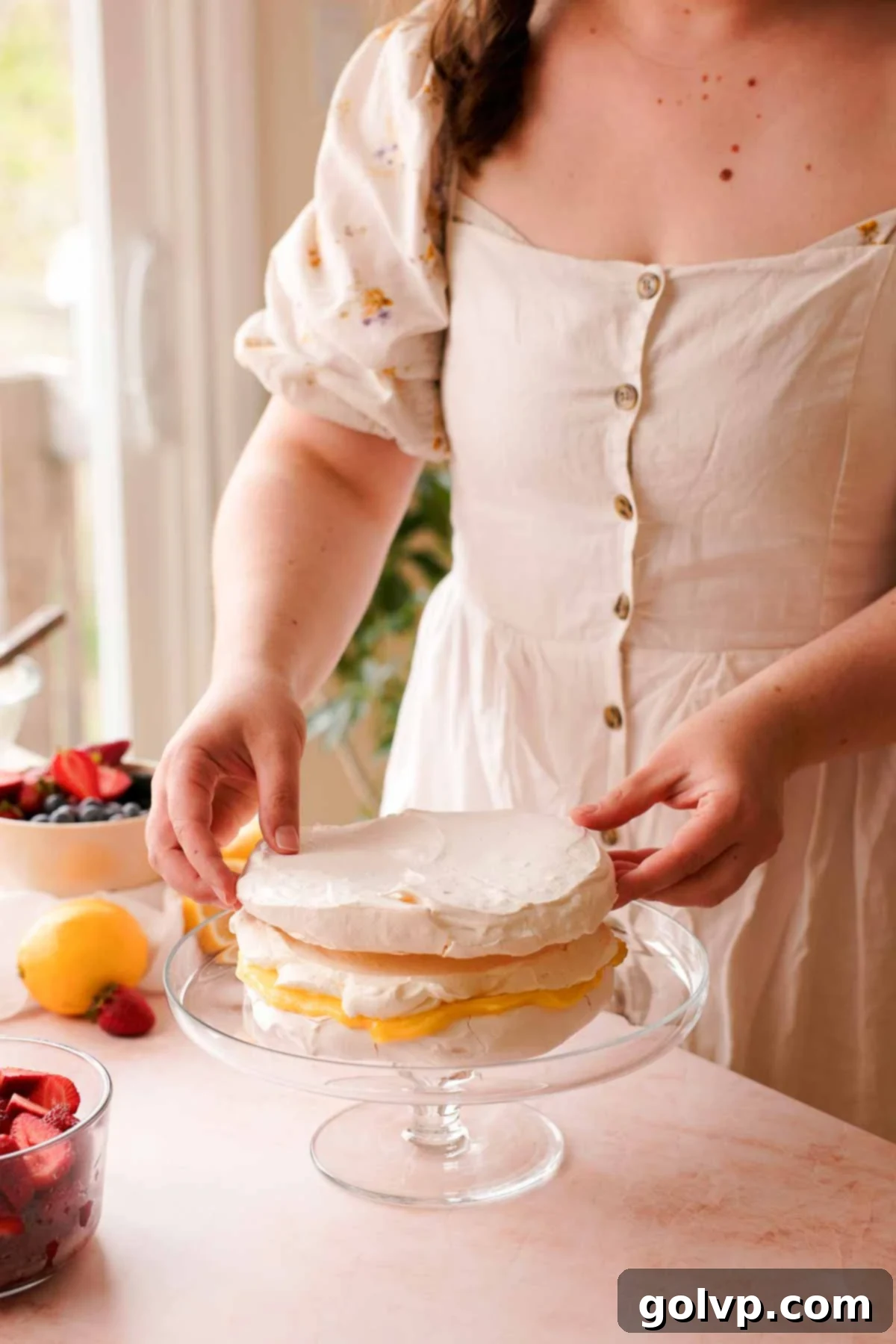
Step 4: Layer the Cream and Remaining Pavlova. Next, spread one-third of the whipped cream evenly over the curd layer. Carefully place the second pavlova disk on top. Repeat the layering process: spread the remaining half of the chilled curd, followed by another third of the whipped cream. Finally, gently place the last pavlova disk on the very top of the cake. Pile the remaining whipped cream on this top layer, creating a beautiful, cloud-like crown.
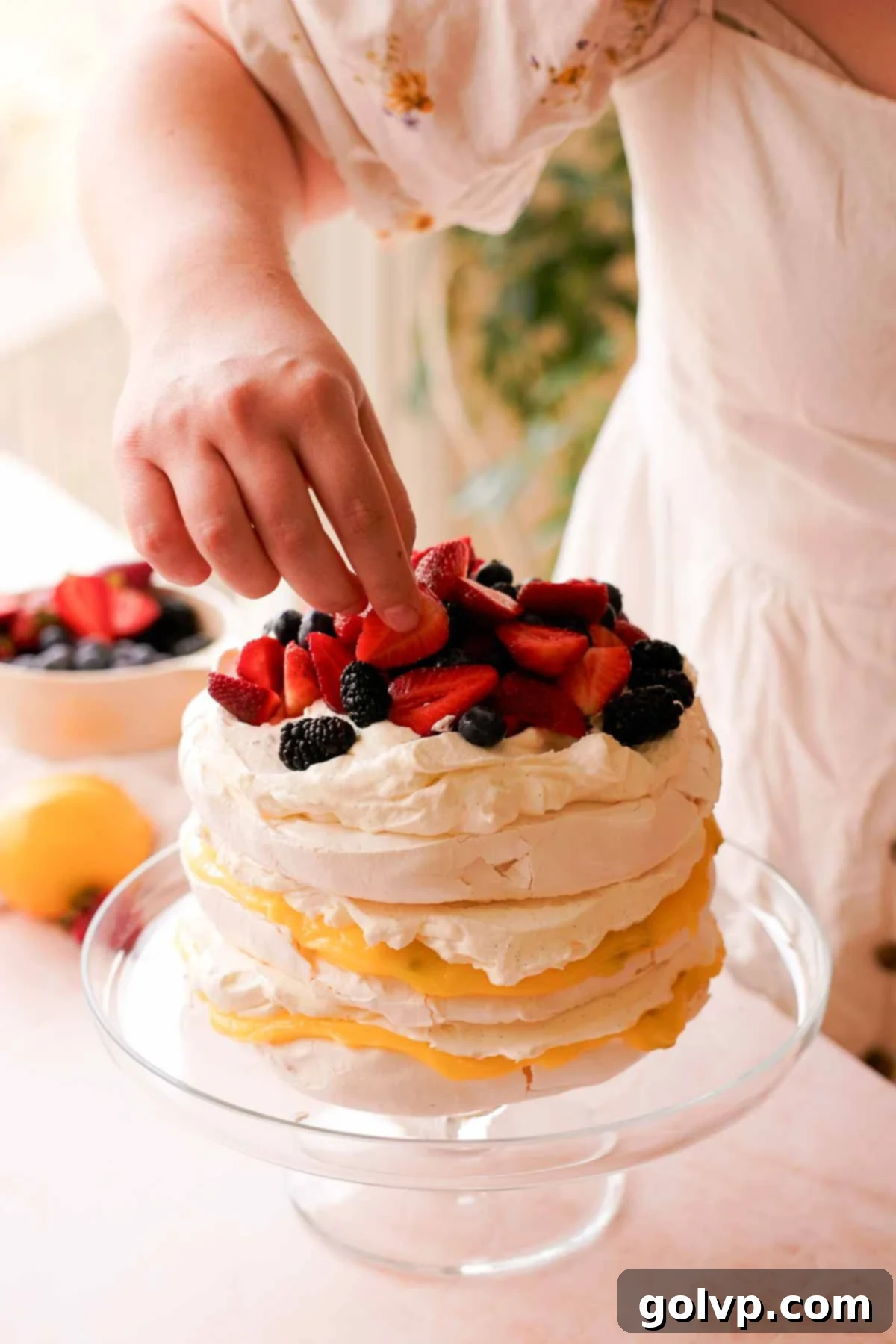
Step 5: Garnish and Serve. The final touch is to lavishly decorate your stacked pavlova cake with an assortment of fresh berries. A mix of strawberries, raspberries, blueberries, and blackberries adds both vibrant color and a burst of complementary flavor. Slice and serve immediately for the crispiest meringue experience. Pavlova cakes, especially layered ones, can be a little messy to slice, so for easier, cleaner slices that hold their shape better, consider placing the assembled cake in the freezer for an hour or two before serving. Enjoy this magnificent dessert!
Expert Tips for a Flawless Pavlova Cake
Achieving pavlova perfection is within reach with these essential tips:
- Spotless Equipment is Key: Ensure that your mixing bowl (especially if using a stand mixer) and whisk attachment are impeccably clean and completely bone dry. Any residue of grease or even a tiny water droplet can hinder the egg whites from whipping up to their full potential, resulting in a flat, unstable meringue.
- Precise Egg Separation: Take extra care when separating egg yolks from whites. Even the smallest speck of yolk (which contains fat) can contaminate the whites and prevent them from whipping into the necessary stiff peaks required for a stable pavlova structure. Use a three-bowl method: one for cracking, one for whites, one for yolks.
- Gentle Folding of Add-ins: When incorporating vanilla extract and cornstarch into the whipped meringue, use a light hand. Gently fold these ingredients in with a spatula, rather than aggressively mixing. Over-mixing at this stage can deflate the delicate air bubbles in the meringue, leading to a less voluminous and crisp pavlova.
- Resist the Urge to Peek: Once the pavlova is in the oven, do not open the oven door! Sudden changes in temperature and humidity can cause the pavlova to crack extensively or even collapse. Trust the process and let it bake and cool undisturbed.
- Constant Stirring for Curd: When cooking the lemon passion fruit curd, stir frequently and consistently. This prevents the egg yolks from curdling or sticking to the bottom of the saucepan and ensures a perfectly smooth, lump-free, and evenly thickened curd.
Make Ahead and Storage Tips for Your Stacked Pavlova
Planning ahead can make assembly day a breeze. Here’s how to prepare and store each component:
Pavlova Layers: I highly recommend making your pavlova layers the night before you plan to assemble the cake. After baking, simply turn off the oven and let the layers cool completely inside for several hours, or even overnight. This extended, slow cooling period helps to create the crispiest exterior and prevents cracking. Store the cooled pavlova layers uncovered at room temperature; wrapping them can trap moisture and make them soft, losing their desired crispness.
Lemon Passion Fruit Curd: The curd is an excellent component to prepare in advance. You can make it a day or two before assembly. Once cooled, transfer it to an airtight container, pressing plastic wrap directly onto the surface to prevent a skin from forming. Store it in the refrigerator until you’re ready to use it, ensuring it’s thoroughly chilled for the best spreading consistency.
Whipped Mascarpone Cream: For the freshest and most stable whipped cream, it’s best made right before you are ready to assemble the pavlova. While the mascarpone helps to stabilize it, freshly whipped cream will always have the best texture and volume.
The Whole Cake (Assembled): For the ultimate crisp pavlova exterior, slice and serve the cake immediately after assembly. However, if you need to assemble it a few hours in advance, you can store it in the freezer. This has the added benefit of making the cake much easier to slice neatly, as the layers firm up. Just be aware that extended freezer time might slightly soften the meringue over time.
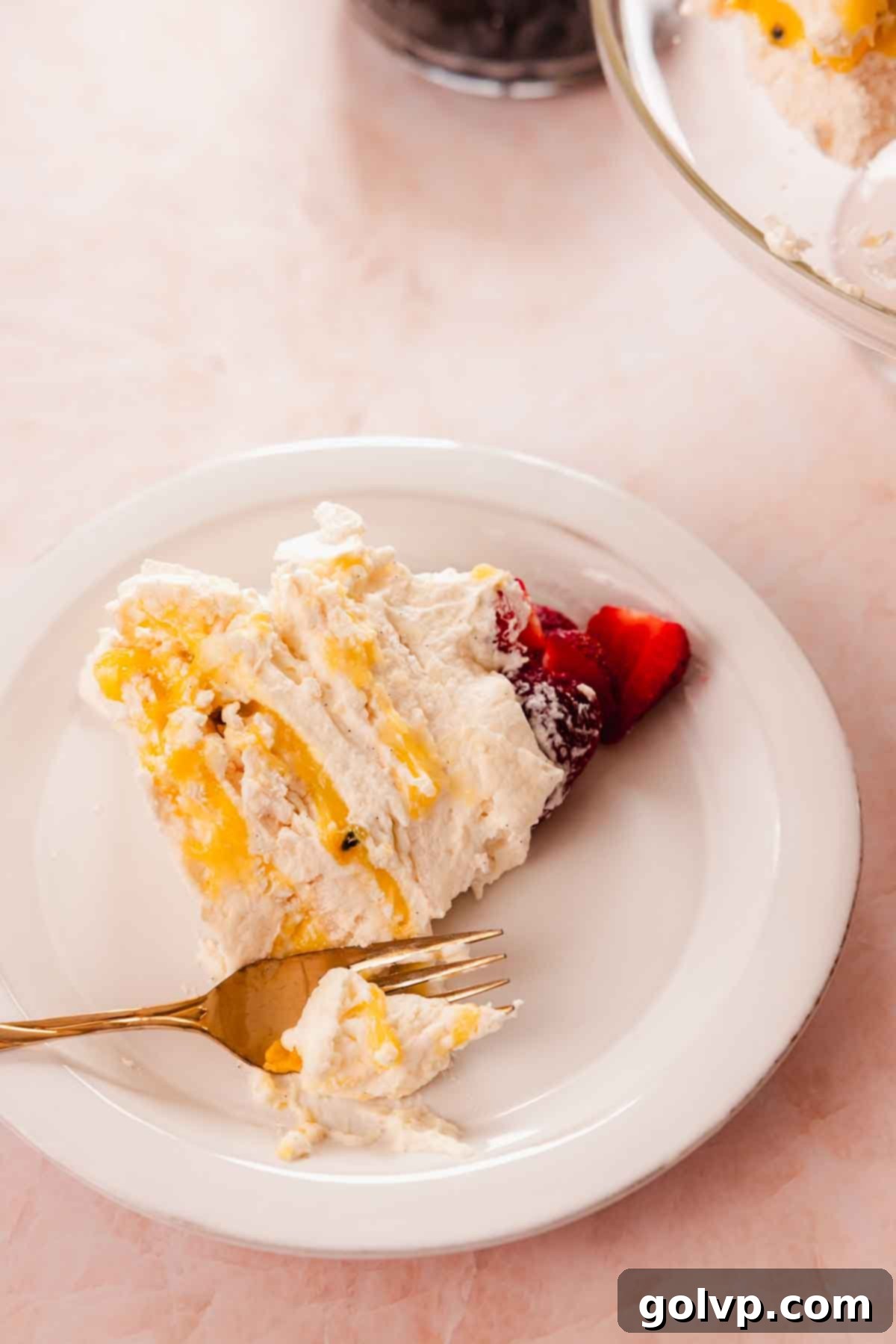
Explore Other Delicious Curd Filling Flavors
While our lemon passion fruit curd is truly outstanding, this versatile pavlova cake can be paired with a variety of other delicious curd fillings. If you’re looking to experiment or prefer a different fruit profile, explore these fantastic options:
- Zesty Raspberry Curd
- Tart Cherry Curd
- Creamy Strawberry Curd
- Sweet Peach Curd
- Vibrant Purple Blueberry Curd
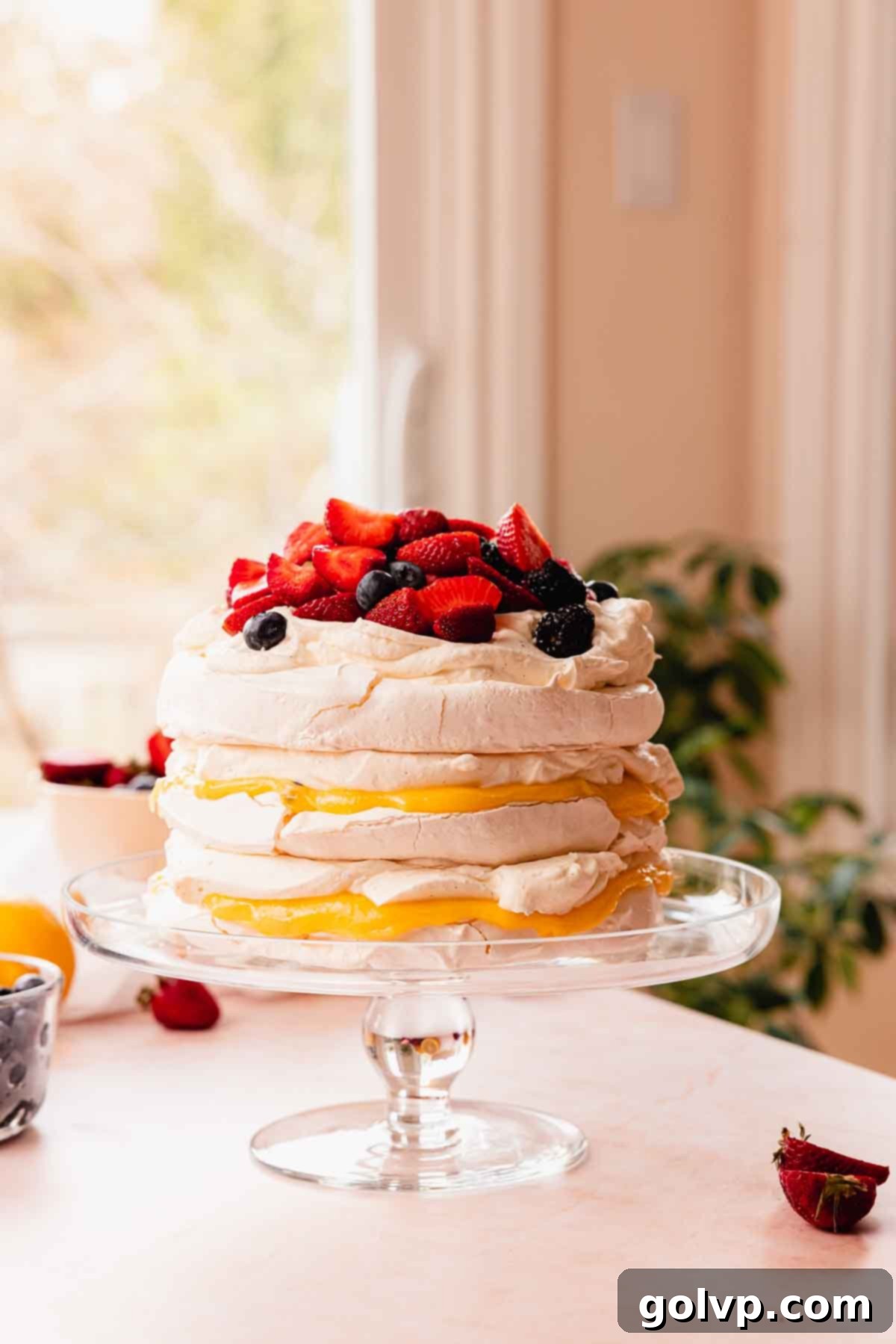
Recipe Frequently Asked Questions
No, I strongly advise against using all-purpose flour for pavlova. Flour has a different chemical composition and texture, and it tends to clump up when folded into meringue, resulting in pockets of uncooked flour in the baked pavlova. It also won’t provide the same tender, pillowy interior that cornstarch does. For an alternative to cornstarch, you could use potato starch or arrowroot starch, as they offer similar moisture-absorbing and stabilizing properties without affecting the texture negatively.
Cornstarch plays a critical role in creating the iconic pavlova texture. It acts as a crucial stabilizer by absorbing excess moisture from the egg whites during the baking process. This absorption helps the meringue set into its characteristic crisp outer shell and soft, marshmallow-like interior. Without cornstarch, pavlova is much more prone to weeping, becoming sticky, or collapsing. You only need a small amount – for 6 egg whites, 2 teaspoons of cornstarch are perfectly sufficient to achieve a truly foolproof and beautifully textured pavlova.
Preventing collapse and cracking in pavlova involves a few key techniques. First, baking the pavlova in a hot oven initially (340°F/170°C) and then immediately reducing the temperature to a much lower heat (240°F/115°C) helps to quickly set and solidify the meringue’s exterior. This forms a protective crust that enables the layers to hold their structure. Secondly, and perhaps most importantly, do not open the oven door while the pavlova is baking or cooling. Sudden fluctuations in temperature and humidity can cause the delicate meringue to deflate and crack. Finally, allow the pavlova to cool completely inside the oven, with the door closed, for several hours or even overnight. This slow, gradual cooling process is essential for the center to set into a beautiful, pillowy-soft marshmallow consistency and helps maintain the structural integrity of the entire meringue.
More Related Dessert Recipes You’ll Love
If you enjoyed this stacked pavlova cake, you might also love these other delightful dessert recipes perfect for any occasion:
- Strawberry Vanilla Cake
- Lemon Raspberry Cake
- Lemon Poke Cake
- Fresh Strawberry and White Chocolate Cupcakes
Did you make this recipe? I would love for you to rate this recipe and hear what you think in the comments below! Share your creation on Instagram and tag @flouringkitchen. Follow me on Pinterestto save and for more recipe ideas.
📖 Recipe

Passion Fruit Lemon Curd Stacked Pavlova Cake
Mary
Pin Recipe
Shop Ingredients
Equipment
-
stand mixer or electric hand mixer
-
parchment paper
-
Cookie sheet
Ingredients
Pavlova Layers
- 6 large eggs cold, you will need the yolks for the curd
- ½ teaspoon cream of tartar or 1 teaspoon white vinegar
- 1 ½ cups granulated sugar
- 1 teaspoon pure vanilla extract
- 2 teaspoons cornstarch
Lemon Passion Fruit Curd
- 6 large egg yolks leftover from the meringue
- ⅔ cup granulated sugar
- ⅓ cup lemon juice freshly squeezed
- 1 passion fruit
- 100 g white chocolate 1 bar, chopped
- ¼ cup butter
- ¼ teaspoon sea salt
Whipped Cream
- 2 cups heavy whipping cream chilled
- ½ cup granulated sugar
- 1 cup mascarpone cheese chilled
- 1 tablespoon vanilla bean paste or 1 scraped vanilla bean pod
- ¼ teaspoon sea salt
- 1 cup berries for topping
Shop Ingredients on Jupiter
Instructions
Pavlova Layers
-
Preheat the oven to 340°F (170°C). Find a plate or cake pan that is about 6 to 7 inches in diameter. Trace three circles onto parchment paper with a pencil and flip the parchment paper over. Place the parchment paper onto baking sheets.
-
Separate the eggs, being very careful not to get any yolk into the whites. Place the whites into a clean and dry bowl of a stand mixer.6 large eggs
-
Add cream of tartar to the egg whites and whip on medium-high speed with a whisk attachment. After about 30 seconds, gradually add the sugar, about one tablespoon at a time, while the mixer is running.½ teaspoon cream of tartar, 1 ½ cups granulated sugar
-
Keep whipping until the mixture reaches stiff peaks. If you pull the whisk out, the meringue will hold its shape firmly. This will take about 10 minutes. When you rub the mixture between your fingers, it should feel smooth, not gritty.
-
Add the vanilla extract and mix on low briefly. Then, sprinkle cornstarch on top and fold it in gently with a spatula. Don’t mix too long or it will deflate!2 teaspoons cornstarch, 1 teaspoon pure vanilla extract
-
Scoop the meringue into the middles of the three traced circles on the parchment paper. Then, gently smooth out the tops and sides into even layers, using the circles as guides. The layers will spread by about half an inch so leave room.
-
Place the baking sheets into the oven. close the oven door and reduce the temperature to 115°C (240°F). Bake for one hour. Don’t open the oven door! Then turn the oven off and let the pavlova cool inside the oven. You can let it cool overnight like I did. Or let it cool for about one to two hours. While it bakes, I make the curd.
Lemon Passion Fruit Curd
-
Combine the egg yolks and sugar in a medium saucepan. Stir together until well mixed.6 large egg yolks, ⅔ cup granulated sugar
-
Add lemon juice and scoop out the insides of one passion fruit into the sauce pan. Heat on low heat, stirring frequently and continuously, until the mixture boils gently and thickens significantly, coating the back of a spoon.⅓ cup lemon juice, 1 passion fruit
-
Immediately remove the thickened curd from the heat. Add chopped white chocolate, butter, and salt. Stir together until all ingredients are fully combined and melted, forming a smooth and glossy curd.100 g white chocolate, ¼ cup butter, ¼ teaspoon sea salt
-
Transfer the curd into an airtight container. Press plastic wrap directly onto the surface of the curd to prevent a skin from forming. Refrigerate until thoroughly cold and firm.
Whipped Cream and Assembly
-
On the day of assembly, whip the cold heavy cream and granulated sugar in a large bowl with a whisk attachment until medium peaks form.2 cups heavy whipping cream, ½ cup granulated sugar
-
Add the chilled mascarpone cheese, vanilla bean paste, and sea salt to the whipped cream. Continue whipping until stiff peaks are achieved, ensuring the cream is firm and stable.1 cup mascarpone cheese, 1 tablespoon vanilla bean paste, ¼ teaspoon sea salt
-
Carefully peel the cooled pavlova disks from the parchment paper. Place a small dollop of whipped cream onto a large cake plate or stand to secure the first layer. Position the first pavlova layer on top, then spread half of the chilled lemon passion fruit curd evenly to the edges.
-
Add one-third of the whipped cream over the curd and spread evenly. Carefully place the second pavlova disk. Repeat the curd and cream layers. Gently place the final pavlova disk on top and pile the remaining whipped cream high, creating an impressive finish.
-
Decorate generously with fresh berries. Slice and serve immediately for the optimal crisp texture. For easier, cleaner slicing, consider freezing the assembled cake for 1-2 hours before serving.1 cup berries
Notes
- Pavlova Layers: For the best results, prepare your pavlova layers the night before assembly. After baking, let them cool completely inside the turned-off oven (for several hours or overnight). This slow cooling method helps achieve a crisper exterior and prevents cracking. Store the cooled layers uncovered at room temperature to maintain their crispness; wrapping can cause them to soften.
- Lemon Passion Fruit Curd: This component is perfect for making in advance. It can be prepared a day or two before you plan to assemble the cake. Once cooked and cooled, transfer the curd to an airtight container and press plastic wrap directly onto its surface to prevent a skin from forming. Refrigerate until thoroughly chilled and firm.
- Whipped Cream: For optimal freshness, volume, and stability, the mascarpone whipped cream is best made right before you are ready to stack and serve your pavlova.
- The Whole Cake: While the assembled cake is best served immediately for peak crispness, it can be put together a few hours before serving. For easier slicing and a more stable structure, especially if serving later, pop the assembled cake into the freezer for an hour or two. This firming-up process helps the layers hold together beautifully when cut.
Tips for success:
- Ensure that the bowl and whisk for the meringue are squeaky clean and bone dry to allow the egg whites to whip perfectly.
- Separate the eggs very carefully, making sure no egg yolk contaminates the whites, as fat will prevent the meringue from achieving stiff peaks.
- Carefully and gently fold the vanilla and cornstarch into the meringue to avoid deflating the air you’ve incorporated.
- Do not open the oven while the stacked pavlova bakes or cools, as sudden temperature changes can cause cracking and deflation.
- Stir the curd frequently as it cooks to prevent it from clumping or burning at the bottom of the saucepan.
